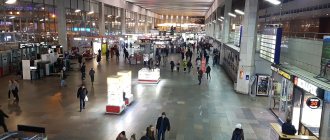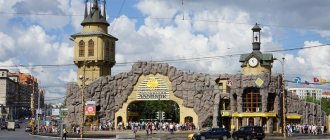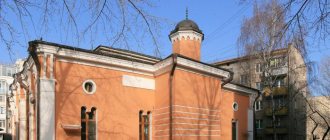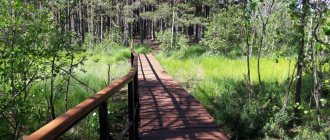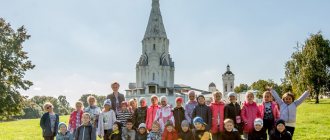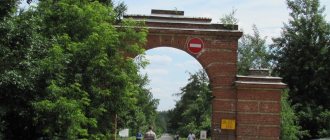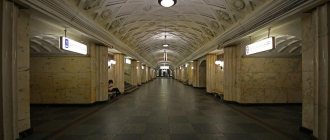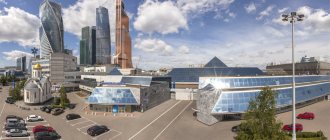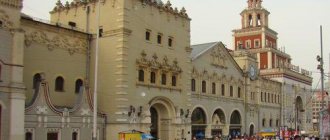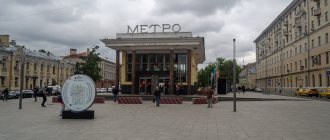The Pechatniki district in the South-Eastern District is located on the left bank of the Moscow River and covers an area of about 2,000 hectares. In the south and west it is limited by the river floodplain, in the north – by the Third Transport Ring and Volgogradsky Prospekt, in the east – by the Kursk branch of Russian Railways. The population exceeds 86 thousand people, and the housing area is 1360 thousand sq.m. Pechatniki is a quiet area with relatively good transport accessibility (when compared with other places in the South-East Administrative District). Real estate is concentrated in the north, and almost the entire southern part is occupied by a vast industrial zone. As a result, the environment is not the best, there is a lack of a large number of new buildings and affordable housing prices.
Pechatniki District - history from its foundation to the present day
The first mention of the area in historical documents dates back to the 16th century, when the village of the same name appeared here. Historians still argue about the origins of the name. It is believed that the founder of the village was Vladimir Pechatnikov, who died during the Livonian War. According to another version, in this area they dyed chintz using wooden forms, a method called “printing”. Be that as it may, the village developed rapidly, and during the Battle of Kulikovo, the Nikolo-Perervinsky monastery was built here, which is the main attraction of the area today.
Pechatniki district map
Pechatniki became part of the city in 1960, and the district was formed in 1995. However, the familiar appearance has been well preserved here. Once you find yourself in certain areas of Pechatniki, it’s even hard to believe that you are in a metropolis. Thus, in the Kuryanovo microdistrict there are still many two-story buildings surrounded by gardens and flower beds. These regions are chosen by directors for filming historical films about life in the 20th century.
Moscow.org Moscow city portal
The history of the Pechatniki district, which belongs to the South-Eastern administrative district of Moscow, is closely intertwined with the history of several ancient villages, such as Pechatnikovo, Batyunino, Kuryanovo, as well as an area called Pererva. All of them developed as a single geographical, economic, social and demographic entity.
The development of this territory began in the 10th century. Around the time of the Battle of Kulikovo, the Nikolo-Perervinsky monastery was founded.
The monastery was located on a high hill, on the banks of the Moscow River. From this elevation there was a wide view, and one could see the domes of Moscow churches. It was a wonderful place for those seeking peace and solitude, which attracted many believers.
Initially, the monastery was named in honor of the wonderworker St. Nicholas the Old, after the main temple. The word Pererva was added to the name in the 17th century, when after the spring flood the Moscow River did not return to its old channel, but turned to the right to the village of Kolomenskoye, located opposite the monastery on the other bank.
During the reign of Alexei Mikhailovich, the monastery received generous donations from both the tsar and other wealthy individuals, which significantly improved its position. In 1669, a copy of the Iveron Icon of the Mother of God, one of the most revered images in Rus', was brought to the Nikolo-Perervinsky Monastery from Athos.
Perhaps the most notorious event associated with the Nikolo-Perervinsky Monastery was the imprisonment of Metropolitan Philip Kolychev in 1567. Kolychev was exiled here for daring to openly condemn Tsar Ivan the Terrible and his bloody oprichnina. Not only the Metropolitan himself suffered for his words, but also many of his relatives and friends. So, as a “gift”, Ivan the Terrible sent Philip the head of his beloved nephew. In response, the Metropolitan blessed the terrible offering and then returned it to the king's envoy. Many Muscovites then gathered at the walls of the monastery to express sympathy for the disgraced metropolitan, and fearing a popular revolt, the tsar sent guardsman Malyuta Skuratov to Philip, who killed the prisoner.
At the beginning of the 18th century, the monastery became a place of imprisonment for guilty clergy. In 1764, the monastic possessions were secularized, and 79 peasants of the Perervinskaya Slobodka became economic. After some time, the monastery itself lost its former significance and was assigned to the Miracle Monastery.
In 1775, Moscow Metropolitan Platon founded a seminary in the Nikolo-Perervinsky Monastery. In 1784, a teachers' building was built here, in 1805 - a seminary building and a new bishop's house. In 1830-1832, according to the design of the architect M.I. Beauvais built a building for a religious school on the territory of the monastery, which began work in the 1820s. The last thing that was built in the monastery was the Cathedral of the Iveron Icon of the Mother of God. It was erected in 1904 according to the design of architect P.A. Vinogradova.
In the mid-18th century, settlements of Old Believers arose in the Pererva area. In 1853 their number was 170 inhabitants. According to documents from 1852, in Perervinskaya Sloboda, which belonged to the Appanage Department, there lived 282 male souls and 311 female souls. There were 67 households in the village. At the end of the 19th century the population grew to 871 people.
The next significant event in the life of Pererva was the construction of the Pererva dam and lock. These structures were built in 1870 to maintain a navigable water level in the Moscow River. The dam existed until 1935, and then it was dismantled and a hydraulic complex was built, thanks to which the water level in the river rose by 3 meters. After the railway was built near Pererva in 1881, dachas began to appear here.
In September 1940, the Nikolo-Perervinsky Monastery was closed. For a long time, its premises housed various cultural institutions and small industries. In 1991, the cathedral St. Nicholas Church was transferred to the Russian Orthodox Church, and in 1993, the remaining churches and buildings of the monastery were returned to the church community.
In 1960, the territory of Pererva became part of Moscow, and the historical name remained in the name of Pererva street.
The next village, which was once located on the territory of the modern Pechatniki district, is the village of the same name. In documentary sources of the 16th century there are two versions of the name of this area: Pechatniki and Pechatnikovo. In the chronicles of 1558 there is a mention of the serviceman Vladimir Pechatnikov, who died during the Livonian campaign. It is believed that the name of the village most likely came from his surname. The second version is based on the fact that in the 18th century in this area, when dyeing chintz, a wooden form with a carved relief pattern was used. This relief was covered with multi-colored paints, and a variegated patterned fabric was created, that is, it was “printed”.
At the turn of the 14th-15th centuries, massive deforestation began. In the cleared territories, villages and estates were established, temples were erected and lands were plowed. Commanderies were created, consisting of different settlements. The peasants of these villages were considered state-owned, and the village of Pechatniki was among them. Church documents from 1774 say that Pechatniki belong to the parish of the Znamenskaya (Trinity) Church in the village of Karacharovo. There were 40 households in the village, the residents were engaged in farming, although the lands here were swampy and gave a poor harvest. The local lands were rich in game, and according to legend, Tsar Alexei Mikhailovich often hunted here. In addition, the ancient road to Kolomna passed through the village of Pechatniki.
In 1803-1804, all state-owned villages were transferred to specific departments. In 1876, the Pererva Zemstvo School began operating, teaching peasant children from villages that belonged to the appanage department. At that time, the population of Pechatniki reached 600 people, among whom was the later famous working poet Philip Stepanovich Shkulev.
In the 1930s, Pechatniki became part of the city of Lyublino, and in 1960 the former village was annexed to Moscow. After this, massive residential construction began here, the area began to be improved, and all the necessary infrastructure was created.
The village of Batyunino, also located on the territory of the modern Pechatniki district, was inhabited by fishermen. This village was part of the Kolomna palace volost; the first reliable information about it dates back to the 17th century. At that time, ten families of fishermen lived here, who passed on their craft from generation to generation.
The duty of the fishermen of the village of Batyunino was to hand over a certain amount of fish for the sovereign's needs. The village was located on the shores of Lake Batyuninsky, which was one of many in this area. In these lakes, fishermen caught fresh fish for the royal table, and also bred them and made sure that strangers did not fish in these lakes.
For their service, fishermen were given land plots. After the capital of Russia was moved to St. Petersburg, fishing came to naught, and residents were transferred to cash rent. In the mid-18th century, Batyunino belonged to the Piece Department. There were 31 households in the village, and 95 males and 117 females lived. At the end of the 19th century, the village's population increased to 302 inhabitants.
The neighboring village of Kuryanovo was located on the shore of another lake - Kuryanovo. At first, it was also part of the Palace domains, and then came under the control of the Whole Department. In the mid-19th century, there were 108 households and 229 residents in Kuryanovo.
In 1926 there were already 108 households here. In the 1930s, the village became part of the Ogorodny Gigant collective farm. When it was decided to give up the local lands for the construction of aeration fields, the residents of Kuryanov were relocated to a specially built village located near the Shcherbinka railway station. This village was called Novokuryanovka. Construction of the Kuryanovskaya aeration station began before the Great Patriotic War, and was completed only in 1950. In 1978, the Novokuryanovskaya station was put into operation, becoming the largest in Europe.
Currently, the Pechatniki district is one of the large industrial centers of Moscow. The industrial zone occupies about 67% of the total territory here. In Pechatniki there is a station of the same name on the Lyublinsko-Dmitrovskaya Line of the Moscow Metro.
Historical reference:
1380 - the Nikolo-Perervinsky monastery was founded in 1567 - the disgraced Metropolitan Philip Kolychev was imprisoned in the Nikolo-Perervinsky monastery 1558 - there is a mention of the serviceman Vladimir Pechatnikov, who died during the Livonian campaign in 1623 - the first documentary evidence of the existence of the Nikolo-Perervinsky monastery 17 V. – the first information about the village of Batyunino in the 18th century is found. - Batyunino belonged to the Piece Department in 1774 - it is said that Pechatniki belonged to the parish of the Znamenskaya (Trinity) Church of the village of Karacharovo 1764 - the monastic possessions were secularized, and 79 peasants of the Perervinskaya Slobodka became economic 1775 - Moscow Metropolitan Platon founded in Nikolo -Perervinsky monastery seminary 1784 - a teacher’s building of the 18th century was built in the monastery. - settlements of Old Believers arose in the Pererva area 1805 - a seminary building and a new bishop's house were built 1820. - on the territory of the Nikolo-Perervinsky Monastery according to the design of the architect P.A. Vinogradov built the Cathedral of the Iveron Icon of the Mother of God 1830-1832. - designed by architect M.I. Beauvais built a building for a religious school on the territory of the monastery 1881 - a railway was built near Pererva, and dachas began to appear here 1870 - to maintain a navigable water level in the Moscow River Pererva dam and lock 1930s - Printers entered became part of the city of Lyublino in 1930. - the village of Kuryanovo became part of the collective farm Vegetable Giant 1935 - its dam was dismantled and a waterworks complex was built 1940 - Nikolo-Perervinsky Monastery was closed 1950 - construction of the Kuryanovo aeration station was completed 1991 - St. Nicholas Cathedral was transferred to the Russian Orthodox Church temple 1993 - the rest of the temples and buildings of the Nikolo-Perervinsky Monastery were returned to the community of St. Nicholas Church 1960 - the territory of Pererva became part of Moscow 1960 - the former village of Pechatniki was annexed to Moscow 1978 - the Novokuryanovskaya aeration station was put into operation
Sights and places of leisure – where to go and what to see in Pechatniki?
The area is not rich in attractions, but this does not negatively affect the quality of life. On the territory of Pechatniki there are several objects worthy of attention:
- Nikolo-Perervinsky Monastery with a centuries-old history;
- temple-chapel on the street. Guryanov, built in memory of the victims of the 1999 tragedy (terrorist attack);
- a monument to a front-line nurse, unveiled at a local clinic in 2017;
- Pechatniki Park with a beautiful embankment near the Moscow River is a good place for walking with children and playing sports; there are 5 zones for karting, motorcycle, bicycle, motor sports, and cross-country skiing.
Embankment in Pechatniki
However, as local residents say, there is little entertainment in Pechatniki, so on weekends you have to go to the center of Moscow or other areas. This fact cannot definitely be considered a minus, since it ensures a calm and measured life in the area.
Kapotnya
Of course, the absolute leader in the ranking of the worst districts of Moscow is Kapotnya Southern Administrative District. But you know, the devil is not as scary as he is painted, I have been to Kapotnya many times and the picture is not as terrible as many can imagine. The kids calmly play football in the school stadium, a quiet, measured life, no one is in a hurry, a lot of greenery, regular transport, it’s very cozy. Yes, a developer probably won’t set foot in the area for a long time, and most likely it won’t be here until the oil refinery is located on the territory of Kapotnya. But the locals are okay, they live comfortably and don’t give a damn. People are reluctant to buy secondary real estate in Kapotnya. Potential buyers of capital housing are disowning the area like hell - but not Kapotnya! Needless to say, prejudices and biases, which under certain circumstances are very difficult to argue with. More recently, for example, in 2021, a 1-room apartment in Kapotnya could be found for mere pennies - 3.8 million rubles for Moscow is the absolute minimum - the cheapest housing in Zlatoglavaya was sold here. However, the situation has changed dramatically and now for 2021 - 2020 the cost per square meter has increased sharply and is approximately 140 thousand rubles per sq. m. And extrapolating to full-fledged separate housing, we can say that a 1-room apartment in Kapotnya now costs somewhere around 5 million rubles, plus or minus 200 thousand. But clients are in no hurry to consider an area for their residence - the stigma attached is very difficult to wash away and, according to most experts, Kapotnya remains the worst area of Moscow in terms of their own residence.
Infrastructure and ecology of the Pechatniki district
The area is rapidly developing and transforming. The Moscow authorities have placed the main emphasis on social infrastructure and the development of parks. Today on the territory of Pechatniki there are:
- 2 clinics;
- 18 kindergartens;
- 12 secondary schools;
- 4 branches of institutes;
- a technical sports park unique for Moscow;
- BMX velodrome based on the Olympic Reserve Sports School, built in 2021;
- grocery stores, including Lenta, Perekrestok, Pyaterochka, VkusVill, etc.
The environment in Pechatniki, as in other areas of the South-Eastern Administrative District, is not the most favorable in the capital. The location of the Kuryanovsky treatment facilities (the oldest in Moscow) on the territory has an effect. There are also several here, “Topaz”, “Mezoplast”, Wood Products Factory”, “Rospolymer”. However, the presence of parks and landscaped green areas makes it possible to improve the environmental situation in Pechatniki.
Kuryanovo
The neighboring village of Kuryanovo, which once stood on the shores of Lake Kuryanovo and which is now reminiscent of four Kuryanovo streets, two passages and a boulevard, had a similar story.
Just like neighboring villages, Kuryanovo was first part of the palace estates, and then transferred to the Integral Department. In the middle of the 19th century. in the village there were 25 households, 119 males and 110 females. By the end of the century, 252 people lived here.
In 1926, Kuryanovo had 108 households. In the 1930s, village residents worked on the “Garden Giant” collective farm. Later, these places were chosen for the construction of an aeration station, and all the inhabitants of Kuryanov were relocated to a village built for them near the Shcherbinka railway station, which was named Novokuryanovo. Construction of the station began before the Great Patriotic War, but was then interrupted until 1947. In December 1950, it went into operation. Subsequently, the station was expanded several times, and in 1978, the Novokuryanovskaya station, the largest in Europe, was launched next to the old one.
Transport in the Pechatniki area (SEAD)
The main transport routes of the area are st. Shosseynaya, Pererva, Donetskaya, Polbina, Yuzhnoportovaya. During peak hours, traffic jams accumulate at the entrance to Volgogradsky Prospekt, which negatively affects the transport situation in Pechatniki. At the same time, serious congestion is rare here, and it is possible to get onto the Third Transport Ring Road or the Moscow Ring Road much faster than in neighboring Lyublino and Maryino. The constructed section of the road between the street. Donetskaya and Shosseynaya further facilitated the exit of area residents towards the Moscow Ring Road.
MCD map
Public transport is represented by numerous bus routes. The Pechatniki and Tekstilshchiki metro stations are located in the area. In 2023, it is planned to commission new metro stations “Pechatniki” on the Big Circle Line and “Yuzhny Port” on the Lyublinsko-Dmitrovskaya Line. By 2025, another Kuryanovo station will be launched. On the territory of Pechatniki there are stations of the Kursk branch of Russian Railways: “Kubanskaya”, “Depo”, “Pererva”. In 2016, the Ugreshskaya MCC station was opened
Pechatniki district real estate – housing prices from owners
Pechatniki's housing stock is represented exclusively by apartments on the secondary market. You won’t be able to buy an apartment in Pechatniki in a new building: such offers are not yet available from developers. Average cost of 1 sq.m. meter of housing in the area is about 153 thousand rubles, which is 16.6% lower than in Moscow. The average price per square meter in Pechatniki is:
- 187 thousand rubles. for 1 sq.m. in a one-room apartment;
- 172 thousand rubles. for 1 sq.m. in a two-room apartment;
- 165 thousand rubles. for 1 sq.m. in a three-room apartment;
- 162 thousand rubles. for 1 sq.m. in a multi-room apartment.
The owners are ready to sell an apartment in Pechatniki at a price of 5.5 million rubles. for a one-room apartment with an area of 33 sq.m. in houses built in the 1970s. One-room apartment with an area of 38-39 sq.m. in a house built in the 1990s, it will cost 6.0-6.5 million rubles. The price tag for a similar apartment, commissioned no more than 15 years ago, is at the level of 8-9 million rubles. Against the backdrop of the coronavirus pandemic in May 2021, housing prices in Pechatniki decreased by no more than 1%; real estate here is still in demand.
According to the head of the urban planning bureau MASTER'SPlan, Yulia Zubarik, a comfortable residential area with a school, kindergarten, technology park and multifunctional center will appear on the site of an industrial zone in the Pechatniki district.
New buildings in Pechatniki
Biryulyovo
Is it possible to compare two such different Biryulevs? Of course not. But they have one common drawback, what they have in common is poor transport accessibility. There is not a single metro station in the vast territory, and there never will be. Well, at least the Moscow authorities have nothing in their plans in this regard. Favorite Biryulyovsky routes: along Lipetskaya to Tsaritsyno, or along Podolsk Kursantov to Prazhskaya. That’s right, local residents are forced to take half an hour to get to the metro in a roundabout way. And if East Biryulyovo leaves quite pleasant feelings and impressions after visiting - moreover, recently the appearance of the area has undergone significant changes for the qualitatively better, then after visiting Western Biryulyovo there remains some kind of aftertaste, as if you are not in Moscow, but somewhere in a distant, seedy province. May the residents of small towns and villages forgive me. In addition, half of Western Biryulyovo is occupied by a continuous, no end, industrial zone. The demand for apartments is not great; sometimes you come across price tags for housing that are completely nailed to the ground. So, on average, the cost per square meter varies from 130 to 150 thousand rubles. By Moscow standards, this is almost nothing. 1 room apartment of 33 sq.m. you can find up to 5 million rubles, 2-room 45 sq.m. for about 6.3-6.5 million rubles. But the apartments sold here are creaking, potential buyers are the last, at worst, to consider the prospect of living in Biryulyovo. For many Muscovites, the name of the district is almost a curse; in order to break stereotypes, better changes must occur than are currently happening. In the meantime, and not only for me personally, Biryulyovo is one of the worst districts, if not in all of Moscow, then in its southern part for sure.
Prospects for the development of Pechatnikov - what awaits the area in the future?
Every year, Printers are transformed and become more and more comfortable for life. If earlier many people talked about the terrible environment and tried to sell an apartment in the Pechatniki area, today the population does not want to move. Recently, a picturesque park with a panoramic platform appeared on the Moskva River embankment, and fountains were installed on the central streets. Also, landscaping of the area was carried out, children's and sports grounds were organized. In 2021, the squares near the Tula cinema, near Bayutinsky Pond, and on the street were updated. Kukhmisterova. The MCC appeared in Pechatniki, almost 100% solving the transport problem.
By 2023, the group plans to complete the construction of a residential complex with an area of 340 thousand sq.m. It is expected that there will be business class apartments, a new school with 1,100 places, a kindergarten with 457 places, a multifunctional center, ground parking and a technology park. As a result, local residents will have the opportunity to exchange an apartment in the old part of the area for real estate in a new building, settling in comfortable and prestigious houses. Also, by the end of 2021, it is planned to complete the construction of a children's art school for 600 students. By 2021, the modernization of the Kuryanovsky treatment facilities will be completed, which will improve the environmental situation.
Microdistrict Kuryanovo
The Pechatniki district is a promising place for a comfortable life. With moderate real estate prices, proximity to the Third Transport Ring and the city center, the area has a calm and measured atmosphere. In recent years, huge steps have been taken in the improvement of Pechatniki: parks have been updated, places of leisure and recreation have appeared, new schools, kindergartens. Despite the abundance of industrial enterprises in the south of the region, Pechatniki has a completely normal environment and is favorable for living with children. The construction of new metro and MCC stations can significantly improve the transport situation.
Notes
- ↑ 1 2 3
Indicators of municipalities.
Printers (unspecified)
(inaccessible link). Territorial body of the Federal State Statistics Service for Moscow. Access date: October 16, 2010. Archived February 8, 2012. - ↑ 12
Population of the Russian Federation by municipalities as of January 1, 2021 (Russian). Date accessed: October 17, 2021. Archived October 17, 2021. - ↑ 1 2 3
Characteristics of the Pechatniki district
(unspecified)
(inaccessible link).
MosOpen
. Date accessed: October 3, 2021. Archived October 21, 2017. - Official website of the municipal formation "Pechatniki" // Information about the municipal formation
- All-Russian population census 2002. Volume. 1, table 4. Population of Russia, federal districts, constituent entities of the Russian Federation, districts, urban settlements, rural settlements - regional centers and rural settlements with a population of 3 thousand or more (unspecified)
. Archived from the original on February 3, 2012. - VPN-2010. Appendix 1. Population by district of Moscow (unspecified)
. Access date: August 16, 2014. Archived August 16, 2014. - Population of the Russian Federation by municipalities. Table 35. Estimated resident population as of January 1, 2012 (unspecified)
. Retrieved May 31, 2014. Archived May 31, 2014. - Population of the Russian Federation by municipalities as of January 1, 2013. - M.: Federal State Statistics Service Rosstat, 2013. - 528 p. (Table 33. Population of urban districts, municipal districts, urban and rural settlements, urban settlements, rural settlements) (undefined)
. Retrieved November 16, 2013. Archived November 16, 2013. - Table 33. Population of the Russian Federation by municipalities as of January 1, 2014 (unspecified)
. Access date: August 2, 2014. Archived August 2, 2014. - Population of the Russian Federation by municipalities as of January 1, 2015 (unspecified)
. Access date: August 6, 2015. Archived August 6, 2015. - Population of the Russian Federation by municipalities as of January 1, 2021
- Population of the Russian Federation by municipalities as of January 1, 2021 (Russian) (July 31, 2017). Retrieved July 31, 2021. Archived July 31, 2021.
- Population of the Russian Federation by municipalities as of January 1, 2021 (Russian). Retrieved July 25, 2018. Archived July 26, 2021.
- Population of the Russian Federation by municipalities as of January 1, 2021 (Russian). Date accessed: July 31, 2019.
- Decision of the municipal Assembly of the intra-city municipal formation Pechatniki in the city of Moscow dated August 30, 2004 No. 10-31.
- Symbols of the Pechatniki district (undefined)
(inaccessible link).
MosOpen
. Date accessed: October 3, 2021. Archived October 4, 2017. - ↑ 1 2 V.P.
Magnussen. Reference book. "Moscow environs". - Moscow: Printed by A. Snegireva, 1902. - P. 92. - ISBN 9785446043194. - A new guide to Moscow, the capital of the Russian state. - Moscow: University Printing House, 1833. - P. 334-335. — 394 p.
- ↑ 1 2
Website of the Yuzhnoportovo district
(unspecified)
. xn--b1ahkofaagku5h0a.xn--p1ai. Date accessed: February 24, 2017. - pechatniki.land.ru.
website My District of Moscow, South-Eastern Autonomous District, Pechatniki
(unspecified)
(inaccessible link). Date accessed: July 9, 2021. Archived March 4, 2021. - For extreme sports enthusiasts and lovers of walks: a technical sports park has opened in Pechatniki (Russian). Moscow website
(September 4, 2018). Date accessed: October 28, 2021. - Sobyanin tested the race track in Pechatniki: a new technical sports park opened in the south-east of Moscow | Society News (undefined)
.
mskgazeta.ru
. Date accessed: October 28, 2021. - Technical Sports Park - official website (unspecified)
. - Residents of the South-Eastern Administrative District shared their impressions of visiting the technical sports park in Pechatniki (Russian) (undefined)
.
Southeast Courier
(June 26, 2019). Date accessed: October 28, 2021. - Tallinn Park will be created on the banks of the Moscow River (Russian). The Village
. Date accessed: October 28, 2021. - In Pechatniki, the territory of the Batyuninsky pond was landscaped (Russian) (undefined)
.
Southeast Courier
(August 15, 2019). Date accessed: October 28, 2021. - The square near the Tula cinema will be completely landscaped in 2021 (Russian). pechatniki.mos.ru
. Date accessed: October 28, 2021. - The improvement of the park on Kukhmisterova Street (Russian) is almost complete. pechatniki.mos.ru
. Date accessed: October 28, 2021. - Architectural Bureau A4 - Improvement of the square on the street. Kukhmisterova (Russian). a4arch.ru
. Date accessed: October 28, 2021.
